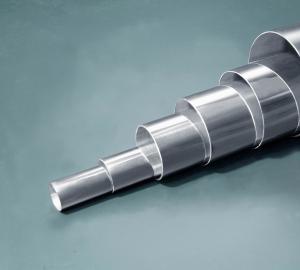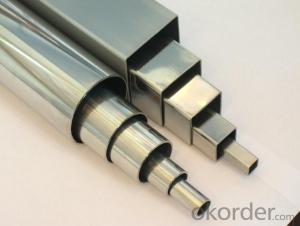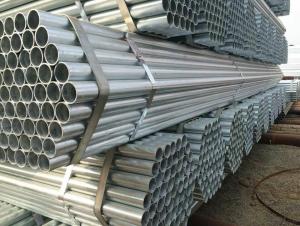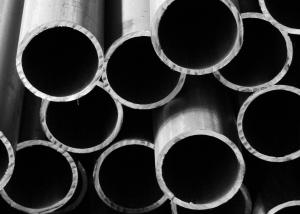STAINLESS STEEL PIPES AND FITTINGS
- Loading Port:
- China Main Port
- Payment Terms:
- TT OR LC
- Min Order Qty:
- -
- Supply Capability:
- -
OKorder Service Pledge
OKorder Financial Service
You Might Also Like
Description:
Stainless Steel Pipe
Material:
304 321 316 310
Packing:
In bundle
MOQ:
5 TONS
Comparison of standardized steels
| EN-standard Steel no. k.h.s DIN | EN-standard Steel name | SAE grade | UNS |
|---|---|---|---|
| 1.4109 | X65CrMo14 | 440A | S44002 |
| 1.4112 | X90CrMoV18 | 440B | S44003 |
| 1.4125 | X105CrMo17 | 440C | S44004 |
| | | 440F | S44020 |
| 1.4016 | X6Cr17 | 430 | S43000 |
| 1.4408 | G-X 6 CrNiMo 18-10 | 316 | |
| 1.4512 | X6CrTi12 | 409 | S40900 |
| | | 410 | S41000 |
| 1.4310 | X10CrNi18-8 | 301 | S30100 |
| 1.4318 | X2CrNiN18-7 | 301LN | |
| 1.4307 | X2CrNi18-9 | 304L | S30403 |
| 1.4306 | X2CrNi19-11 | 304L | S30403 |
| 1.4311 | X2CrNiN18-10 | 304LN | S30453 |
| 1.4301 | X5CrNi18-10 | 304 | S30400 |
| 1.4948 | X6CrNi18-11 | 304H | S30409 |
| 1.4303 | X5CrNi18-12 | 305 | S30500 |
| | X5CrNi30-9 | 312 | |
| 1.4541 | X6CrNiTi18-10 | 321 | S32100 |
| 1.4878 | X12CrNiTi18-9 | 321H | S32109 |
| 1.4404 | X2CrNiMo17-12-2 | 316L | S31603 |
| 1.4401 | X5CrNiMo17-12-2 | 316 | S31600 |
| 1.4406 | X2CrNiMoN17-12-2 | 316LN | S31653 |
| 1.4432 | X2CrNiMo17-12-3 | 316L | S31603 |
| 1.4435 | X2CrNiMo18-14-3 | 316L | S31603 |
| 1.4436 | X3CrNiMo17-13-3 | 316 | S31600 |
| 1.4571 | X6CrNiMoTi17-12-2 | 316Ti | S31635 |
| 1.4429 | X2CrNiMoN17-13-3 | 316LN | S31653 |
| 1.4438 | X2CrNiMo18-15-4 | 317L | S31703 |
| 1.4362 | X2CrNi23-4 | 2304 | S32304 |
| 1.4462 | X2CrNiMoN22-5-3 | 2205 | S31803/S32205 |
| 1.4539 | X1NiCrMoCu25-20-5 | 904L | N08904 |
| 1.4529 | X1NiCrMoCuN25-20-7 | | N08926 |
| 1.4547 | X1CrNiMoCuN20-18-7 | 254SMO | S31254 |
Stainless steel’s resistance to corrosion and staining, low maintenance and familiar lustre make it an ideal material for many applications. There are over 150 grades of stainless steel, of which fifteen are most commonly used. The alloy is milled into coils, sheets, plates, bars, wire, and tubing to be used in cookware, cutlery, household hardware, surgical instruments, major appliances, industrial equipment (for example, in sugar refineries) and as an automotive and aerospace structural alloy and construction material in large buildings. Storage tanks and tankers used to transport orange juice and other food are often made of stainless steel, because of its corrosion resistance. This also influences its use in commercial kitchens and food processing plants, as it can be steam-cleaned and sterilized and does not need paint or other surface finishes.
Stainless steel is used for jewelry and watches with 316L being the type commonly used for such applications. It can be re-finished by any jeweler and will not oxidize or turn black.
Some firearms incorporate stainless steel components as an alternative to blued or parkerized steel. Some handgun models, such as the Smith & Wesson Model 60 and the Colt M1911 pistol, can be made entirely from stainless steel. This gives a high-luster finish similar in appearance to nickel plating. Unlike plating, the finish is not subject to flaking, peeling, wear-off from rubbing (as when repeatedly removed from a holster), or rust when scratched.
Architecture[edit]
Stainless steel is used for buildings for both practical and aesthetic reasons. Stainless steel was in vogue during the art deco period. The most famous example of this is the upper portion of the Chrysler Building (pictured). Some diners and fast-food restaurants use large ornamental panels and stainless fixtures and furniture. Because of the durability of the material, many of these buildings retain their original appearance.
Type 316 stainless is used on the exterior of both the Petronas Twin Towers and the Jin Mao Building, two of the world's tallest skyscrapers.[17]
The Parliament House of Australia in Canberra has a stainless steel flagpole weighing over 220 tonnes (240 short tons).
The aeration building in the Edmonton Composting Facility, the size of 14 hockey rinks, is the largest stainless steel building in North America.
Bridges[edit]
Cala Galdana Bridge in Minorca (Spain) was the first stainless steel road bridge.
Sant Fruitos Pedestrian Bridge (Catalonia, Spain), arch pedestrian bridge.
Padre Arrupe Bridge (Bilbao, Spain) links the Guggenheim museum to the University of Deusto.[18]
Monuments and sculptures[edit]
The Unisphere, constructed as the theme symbol of the 1964-5 World's Fair in New York City, is constructed of Type 304L stainless steel as a sphere with a diameter of 120 feet, or 36.57 meters.
The Gateway Arch (pictured) is clad entirely in stainless steel: 886 tons (804 metric tonnes) of 0.25 in (6.4 mm) plate, #3 finish, type 304 stainless steel.[19]
The United States Air Force Memorial has an austenitic stainless steel structural skin.
The Atomium in Brussels, Belgium was renovated with stainless-steel cladding in a renovation completed in 2006; previously the spheres and tubes of the structure were clad in aluminium.
The Cloud Gate sculpture by Anish Kapoor, in Chicago US.
The Sibelius monument in Helsinki, Finland, is made entirely of stainless steel tubes.
The Man of Steel (sculpture) under construction in Rotherham, England.
Other[edit]
- Automotive bodies
The Allegheny Ludlum Corporation worked with Ford on various concept cars with stainless steel bodies from the 1930s through the 1970s, as demonstrations of the material's potential. The 1957 and 1958 Cadillac Eldorado Brougham had a stainless steel roof. In 1981 and 1982, the DeLorean DMC-12 production automobile used stainless steel body panels over a glass-reinforced plasticmonocoque. Intercity buses made by Motor Coach Industries are partially made of stainless steel. The aft body panel of the Porsche Cayman model (2-door coupe hatchback) is made of stainless steel. It was discovered during early body prototyping that conventional steel could not be formed without cracking (due to the many curves and angles in that automobile). Thus, Porsche was forced to use stainless steel on the Cayman.
- Passenger rail cars
Rail cars have commonly been manufactured using corrugated stainless steel panels (for additional structural strength). This was particularly popular during the 1960s and 1970s, but has since declined. One notable example was the early Pioneer Zephyr. Notable former manufacturers of stainless steel rolling stock included the Budd Company (USA), which has been licensed to Japan's Tokyu Car Corporation, and the Portuguese company Sorefame. Many railcars in the United States are still manufactured with stainless steel, unlike other countries who have shifted away.
- Aircraft
Budd also built an airplane, the Budd BB-1 Pioneer, of stainless steel tube and sheet, which is on display at the Franklin Institute.
The American Fleetwings Sea Birdamphibious aircraft of 1936 was also built using a spot-welded stainless steel hull.
The Bristol Aeroplane Company built the all-stainless steel Bristol 188 high-speed research aircraft, which first flew in 1963.
The use of stainless steel in mainstream aircraft is hindered by its excessive weight compared to other materials, such as aluminum.
- Jewelry
Valadium, a stainless steel and 12% nickel alloy is used to make class and military rings. Valadium is usually silver-toned, but can be electro-charged to give it a gold tone. The gold tone variety is known as Sun-lite Valadium
- Q: Can stainless steel pipes be pickled?
- Yes, stainless steel pipes can be pickled. Pickling is a process that removes surface impurities and oxides from the stainless steel, resulting in a clean and corrosion-resistant surface. This process is commonly used to prepare stainless steel pipes for further treatments or applications.
- Q: What are the different types of stainless steel pipe coatings?
- There are several types of stainless steel pipe coatings that are used to enhance the durability, corrosion resistance, and aesthetic appearance of the pipes. Some of the common types of stainless steel pipe coatings include: 1. Fusion Bonded Epoxy (FBE) Coating: FBE coating is a thermosetting resin-based coating that is applied to the pipes using an electrostatic spray. It provides excellent corrosion resistance and adhesion, making it suitable for both buried and above-ground applications. 2. Polyethylene (PE) Coating: PE coating is a thermoplastic coating that is applied to the pipes using extrusion. It provides high impact resistance and excellent resistance to chemical substances, making it suitable for pipes used in harsh environments. 3. Polypropylene (PP) Coating: PP coating is a thermoplastic coating similar to PE coating but with higher temperature resistance. It is often used for pipes that transport high-temperature fluids. 4. Polyurethane (PU) Coating: PU coating is a thermosetting resin-based coating that is applied to the pipes using a spray or dip method. It provides excellent resistance to abrasion, impact, and chemicals, making it suitable for pipes used in demanding applications. 5. Zinc Coating: Zinc coating, also known as galvanization, is a metallic coating that is applied to the pipes using a hot-dip process. It provides excellent corrosion resistance and is commonly used for pipes used in outdoor and underground applications. 6. Ceramic Coating: Ceramic coating is a high-temperature resistant coating that is applied to the pipes using a thermal spray process. It provides excellent resistance to abrasion, oxidation, and corrosion, making it suitable for pipes used in high-temperature environments. 7. PTFE (Polytetrafluoroethylene) Coating: PTFE coating is a non-stick coating that is applied to the pipes using a spray or dip method. It provides excellent resistance to chemicals and high temperatures, making it suitable for pipes used in the chemical and food industries. These are just a few examples of the different types of stainless steel pipe coatings available. The choice of coating depends on the specific requirements of the application, such as the type of fluid being transported, the operating temperature and pressure, and the environmental conditions.
- Q: How do you calculate the maximum allowable span for stainless steel pipes?
- The maximum allowable span for stainless steel pipes can be calculated by considering various factors such as the material's tensile strength, the pipe's diameter, wall thickness, and the type of support or loading conditions. By using engineering formulas and standards specific to stainless steel pipes, such as those provided by ASME B31.1 or ASME B31.3, one can determine the maximum span that ensures structural integrity and safety.
- Q: What is the difference between Type 304H and Type 316H stainless steel pipes?
- Type 304H and Type 316H stainless steel pipes are both high carbon versions of their respective stainless steel grades. However, there are some key differences between the two. Firstly, Type 304H stainless steel pipe is an austenitic stainless steel that contains 18-20% chromium and 8-10.5% nickel. It also has a maximum carbon content of 0.04-0.10%, which provides improved high-temperature strength and resistance to sensitization (a process that can occur when stainless steel is exposed to high temperatures, leading to grain boundary corrosion). This makes Type 304H suitable for high-temperature applications, such as in the chemical processing industry. On the other hand, Type 316H stainless steel pipe is also an austenitic stainless steel, but it contains higher levels of chromium (16-18%), nickel (10-14%), and molybdenum (2-3%). The addition of molybdenum enhances the corrosion resistance of Type 316H, especially in chloride environments. This makes Type 316H suitable for applications that require excellent resistance to corrosion, such as in marine environments or in the presence of acidic or alkaline solutions. In summary, the main difference between Type 304H and Type 316H stainless steel pipes lies in their chemical compositions and resulting properties. Type 304H offers improved high-temperature strength and resistance to sensitization, while Type 316H offers enhanced resistance to corrosion, especially in chloride environments. The choice between the two will depend on the specific requirements of the application, such as temperature, corrosion resistance, and environmental conditions.
- Q: Can stainless steel pipes be insulated with polylactic acid?
- Yes, stainless steel pipes can be insulated with polylactic acid (PLA). PLA is a biodegradable and renewable thermoplastic polymer that is derived from renewable sources such as corn starch or sugar cane. It is commonly used as an insulation material due to its low thermal conductivity and good insulation properties. To insulate stainless steel pipes with PLA, a layer of PLA insulation can be applied around the pipes. This insulation layer helps to reduce heat loss or gain, prevent condensation, and improve energy efficiency. The PLA insulation can be in the form of sheets or tubes that can be easily wrapped around the pipes. One of the advantages of using PLA insulation is its eco-friendly nature. PLA is biodegradable and does not release harmful toxins during its production or disposal. It is also a sustainable material as it can be derived from renewable resources. Additionally, PLA insulation is resistant to moisture and has good dimensional stability, making it suitable for various applications. However, it is important to note that PLA has a lower melting point compared to stainless steel, so it may not be suitable for high-temperature applications. If the pipes are exposed to extreme heat, alternative insulation materials with higher melting points should be considered. In conclusion, stainless steel pipes can be effectively insulated with polylactic acid (PLA) insulation. PLA insulation offers good thermal properties, is eco-friendly, and can contribute to energy savings. However, it is essential to consider the temperature limits of PLA when using it for insulation purposes.
- Q: How do you clean stainless steel pipes?
- To clean stainless steel pipes, there are a few methods you can use depending on the level of dirt or grime. Firstly, you can start by using warm water and a mild detergent. Mix the detergent with water and use a soft cloth or sponge to wipe down the surface of the pipes. Make sure to go in the direction of the grain to avoid scratching the steel. Rinse the pipes thoroughly with clean water and dry them with a clean, lint-free cloth. If the pipes have tougher stains or buildup, you can try using a vinegar solution. Mix equal parts of vinegar and water and apply the solution to the pipes. Allow it to sit for a few minutes to dissolve the stains, then scrub gently with a soft brush or cloth. Rinse the pipes well with clean water and dry them thoroughly. For more stubborn stains or discoloration, you can use a specialized stainless steel cleaner or polish. Follow the instructions on the product, usually applying it to the pipes and rubbing it in with a soft cloth. Again, make sure to go in the direction of the grain. Rinse the pipes thoroughly with clean water and dry them completely. It is important to note that abrasive cleaners or scrubbing pads should be avoided as they can scratch the stainless steel surface. Additionally, always test any cleaning solution or product on a small, inconspicuous area of the pipes before applying it to the entire surface to ensure it does not cause any damage or discoloration.
- Q: What is the difference between schedule 10 and schedule 160 stainless steel pipes?
- The main difference between schedule 10 and schedule 160 stainless steel pipes is their thickness and pressure rating. Schedule 10 pipes have a thinner wall thickness and a lower pressure rating compared to schedule 160 pipes, which have a thicker wall thickness and a higher pressure rating. Additionally, schedule 160 pipes are typically used for high-pressure applications, while schedule 10 pipes are suitable for low to medium-pressure applications.
- Q: What is the difference between Schedule 5 and Schedule 10 stainless steel pipes?
- Schedule 5 and Schedule 10 stainless steel pipes find frequent use across various industries and applications, though they possess distinct dissimilarities. The primary disparity resides within their wall thickness. While Schedule 5 stainless steel pipes boast a slimmer wall thickness, Schedule 10 stainless steel pipes possess a thicker wall. Consequently, Schedule 5 pipes exhibit a greater internal diameter, facilitating a more substantial flow of fluids or gases through the conduit. On the contrary, Schedule 10 stainless steel pipes exhibit a reduced internal diameter due to their thicker walls. This renders them more suitable for applications necessitating higher pressure or strength, as the heightened wall thickness grants augmented durability and resistance against external forces. Moreover, the disparate wall thicknesses of Schedule 5 and Schedule 10 pipes influence their weight and cost. Owing to their thinner walls, Schedule 5 pipes weigh less and command a lower price than Schedule 10 pipes. Concerning availability, Schedule 10 stainless steel pipes witness more frequent usage in industrial processes involving high pressure or corrosive environments, such as chemical plants or oil refineries. Conversely, Schedule 5 stainless steel pipes are often employed in applications where the flow of fluids or gases does not encounter extreme pressure, such as plumbing or low-pressure conveying systems. In summary, the principal distinctions between Schedule 5 and Schedule 10 stainless steel pipes lie within their wall thickness, internal diameter, strength, weight, and cost. The choice between the two hinges upon the specific requirements of the application and the level of pressure or durability required.
- Q: What kind of welding machine is used for welding thin stainless steel plate and stainless steel square tube?
- 1 argon arc welding machine! If the person who has not been married, as little as possible, that thing has radiation, long time use of physiology is influential. You know what you do.2, regardless of the front and back can be, as long as it looks beautiful and practical.3, welding technology is good, it will not be ugly after welding.4, only the use of technology to make up for the lack of machinery, and then cattle B hardware, there is no good software is not good.5, welding rod, protective mask and so on.
- Q: What is the difference between seamless and drawn-over-mandrel stainless steel pipes?
- Seamless stainless steel pipes are manufactured without any welding or seams, making them stronger and more resistant to corrosion. On the other hand, drawn-over-mandrel stainless steel pipes are produced by drawing a solid stainless steel bar over a mandrel, resulting in a welded seam that may be less durable and more prone to corrosion.
Send your message to us
STAINLESS STEEL PIPES AND FITTINGS
- Loading Port:
- China Main Port
- Payment Terms:
- TT OR LC
- Min Order Qty:
- -
- Supply Capability:
- -
OKorder Service Pledge
OKorder Financial Service
Similar products
Hot products
Hot Searches
Related keywords























